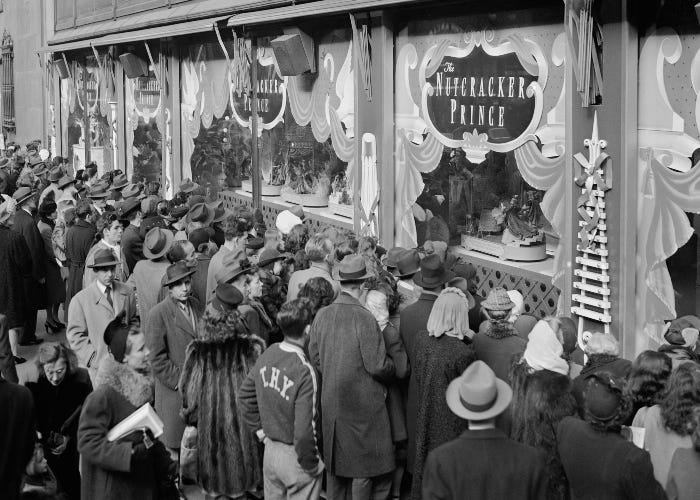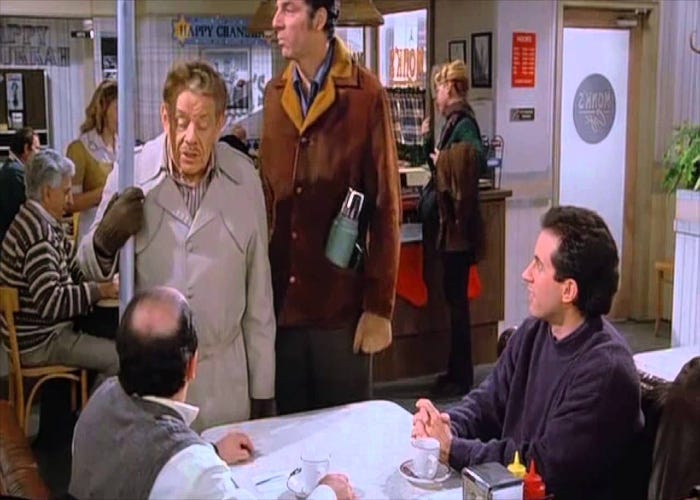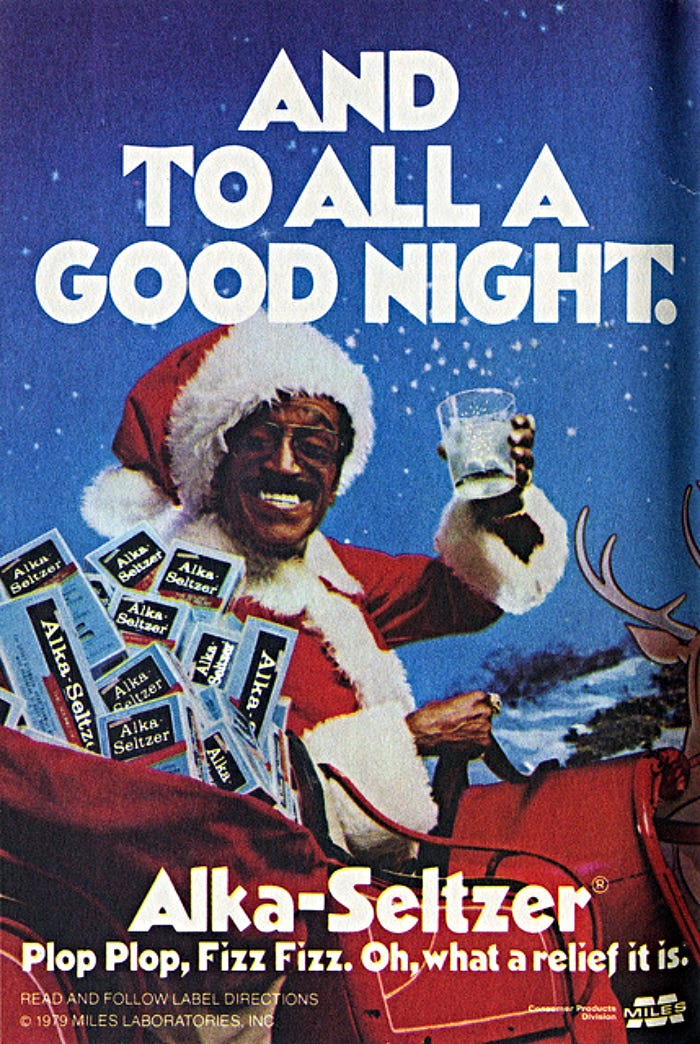This Nostalgic Life is a free weekly publication rich with nostalgia brought to you by co-creators Eric Vardeman and Mick Lee. If this is your first time reading, you can subscribe using the button below so you don’t miss receiving any future issues delivered straight to your inbox.
Welcome to this 30th edition of This Nostalgic Life. Christmas is just a couple of days away, and with that, Eric and Mick are taking time off from writing to enjoy the holiday season with their families. That means no new personal stories in this issue, but what we do have are three articles full of Christmas spirit that span the decades.
On, Comet! on, Cupid! on, Donder and Blitzen!…
The Golden Age of Department Stores at Christmas
In today’s world of specialty shops, discount superstores, and all the choices we have online, it’s hard to imagine the role the department store once played in American life. Each town had one of these emporiums, housing thousands of square feet of merchandise beneath a single roof. Located in the town’s central shopping district, the department store served as a kind of town square. Wealthy people could not go to a “better” store, and poor folks would not be turned away. As an economic blender, it was great.
Department stores also played a unique role at Christmas time. Because their budgets, floor space, and potential profits were so much larger than smaller shops, they took the lead in marketing Christmas as an in-store event. It cost a quarter to go to the movies, but for free one could linger for hours over fantasy windows, spectacular toy lands, mechanized villages, and red-suited Santa, all set against the backdrop of alluring and highly desirable merchandise. Whole families trooped downtown each year to enjoy these spectacles, and a new annual tradition became part of millions of American lives.
Retailed realized early on that windows made ideal picture frames for their merchandise. In the 1920s, Christmas windows took a revolutionary turn. Ed Dean, display manager for Dayton’s department store in Minneapolis, began designing windows that were whimsical rather than merely merchandise-filled. Although Macy’s in New York had long incorporated merchandise into various window themes, Dean’s windows skipped the merchandise altogether. Among his creations were mechanical cutouts illustrating scenes from The Rubaiyat of Omar Khayyam, a life-size elephant that swung its trunk and swished its tail, and several circus acts and nursery rhymes. The idea was to give the windows a new theme each year and to make each season’s offering grander and more alluring than the year before. One year it was dolls, another the circus, and still another nursery rhyme characters.
Soon other stores adopted the merchandise-free strategy, and fantasy windows became the rule of the day. In 1946, Marshall Field’s in Chicago used its long parade of windows to tell the story of The Night Before Christmas from start to finish, which proved so popular with shoppers that the store offered the public a new story every year after that. In cities across America, each season’s store windows became an annual news event, and town residents turned out to see the show. The amount of free advertising, customer goodwill, foot traffic, and attention from the retail world was enormous.
Why are holiday windows always so secular? Has commercialism completely drowned out Christmas’ true origins? It turns out the opposite is true – retailers have always been cautious of anything that might seem to exploit religion. In 1952, to satisfy customers who’d requested a nativity display, Dayton’s in Minneapolis created a sacred side of the store, keeping it separate from the Santas, sleigh bells, toy soldiers, and decorated trees that enlivened the rest of the store.
Windows were by no means the only investment retailers made. Awnings garlanded with holly, Santas, and sleighs climbing store roofs, interior pillars wrapped with pine, elaborately decorated Christmas trees, and Santa Villages and Toylands – all these were important in setting the holiday mood. Marshall Field’s, in Chicago, was a leader in cellar-to-ceiling decorating. In the 1940s, instead of having windows to delight the children and decorations of various sorts in different departments, Field’s designers began decorating the whole store around a single theme. This required not only ingenuity but massive effort as well – the store estimated that some 4,000 employees were required to complete the decorations each year. The effect was dazzling, and people who might before have been content to see only the windows and the main floor now became interested in seeing the whole store, and as they walked through each floor they invariably made purchases.
The 1950s and 1960s were the heydays of downtown windows, with stores striving each season to surpass their previous year’s efforts and those of their competitors. Stores that had kept their windows dark on Sundays began to light them up. Eventually, by the mid-1960s, states started to repeal their Sunday closing laws, and stores began to keep limited hours.
After the 1960s, while large stores could still be counted on for interesting and delightful windows, soaring costs caused many retailers to scale back their efforts, recycle decorations from one season to another, or rely on rented window decorations. An even bigger factor may have been that new feature on the American landscape, the suburban shopping mall. With branches of the main store located in the customer’s own neighborhood, there was no reason to lure shoppers downtown, and the advent of sophisticated attractions like color television, animated movies, television specials, and later VCRs and DVDs, made children just a little less excited about the prospect of pacing a long line of windows in the cold.
The Real History Behind the Fake Holiday Festivus
Seinfeld, a show about nothing, actually gave us something for the holidays: a new December tradition in which everyone can participate.
On December 18, 1997, all of us were introduced to Festivus, the holiday “for the rest of us.” Taking place on December 23rd, this celebration came about after George Costanza’s father Frank fought a heated physical battle for the last toy in a department store. He invented Festivus when he realized there had to be a better way, and developed the holiday focused on family disappointments and feats of strength instead of focusing on materialism.
That’s the history that most of us know, but is that the real origin? The truth is, that the roots of Festivus go back much further than that Seinfeld episode in 1997. Festivus actually got its start in 1966.
Back in 1966, Daniel O’Keefe, an editor at Reader’s Digest, celebrated the anniversary of his first date with his wife, Deborah, and named the party Festivus. Traditions began to evolve after O’Keefe was inspired by Samuel Beckett’s play Krapp’s Last Tape, which features and older man listening to tape recordings of his younger self. O’Keefe started making his own tapes, into which he would record his grievances about life; these tapings became incorporated into Festivus as the O’Keefe family began to record all their complaints too. In the original O’Keefe family tradition, grievance airings were not tied to any particular day and could occur any time between December and May. Grievance airings were also offered on annual themes. In addition to the tape recordings, there would be wrestling matches between O’Keefe’s three sons.
Many years later, O’Keefe’s son Daniel, became a writer for Seinfeld. He recounted the traditions to his fellow writers. The O’Keefe family traditions formed the basis of the Seinfeld Festivus. Ever since the airing of that episode in 1997, Festivus has taken on a life of its own. According to the Seinfeld tradition, the holiday features three primary elements:
The Aluminum Pole: The holiday’s only decoration, the unadorned pole symbolizes resistance to the commercial aspect of the holidays. No tinsel is allowed, as Frank Costanza says it’s “distracting.”
The Airing of Grievances: During the annual Festivus dinner, celebrants go around the table and tell their friends and family how they’ve disappointed them over the past year.
The Feats of Strength: The head of the family must be wrestled to the ground in order for Festivus to end. The head of the family chooses an opponent; that person must then wrestle the head of the family unless it can be shown that they have something better to do.
Another aspect of the Festivus holiday is the Festivus Miracle…a miracle that is only slightly better than no miracle at all. Finding 35 cents in your pocket instead of a quarter would qualify. So would picking up the phone on the fifth ring just before the caller hangs up is another good example. Festivus miracles are all around us.
Seinfeld fans were delighted by the absurd holiday and took it for their own. And now we have a real holiday made fictional and then real again. Festivus parties have become popular with friends and families around the country. Many now put up their own aluminum poles for the holiday. Others have created Festivus greeting cards to list the ways they’ve been disappointed by others throughout the year.
In 2004, the holiday even moved into the public realm for the first time when in Bartow, Florida, a plywood sign stood next to other holiday displays. It read: “Festivus for the Rest of Us. Donated to Polk County by the Seinfeld Fan Club.” Some folks were not amused and aired their grievances to the county commissioners. But it looks like Festivus is here to stay. So enjoy your aluminum pole, and your feats of strength, and celebrate Festivus with the Rest of Us!
An Appalachian Christmas Carol
A special audio presentation.
This Nostalgic Life is happy to be able to present to you a special audio presentation of “An Appalachian Christmas Carol” recorded by Mick Lee. It’s a tale that blends real life with a little fantasy and takes place in the glory years of the 1980s. Listen along as Mick relates a magical tale filled with wonder that is sure to brighten your holiday season.
We hope you’ve enjoyed this edition of This Nostalgic Life. We’ll be returning to our regular publication day on Wednesday with the next issue so watch for that to drop in your inbox.
Until then, we want to wish each and every one of you a very Merry Christmas. We hope its one filled with wonder and joy for you and your family.















